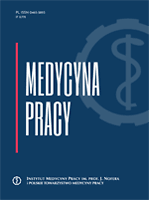
Medycyna Pracy-Workers Health and Safety
Scope & Guideline
Advancing worker health through innovative research.
Introduction
Aims and Scopes
- Occupational Health and Safety:
Research dedicated to understanding and improving health conditions within various occupational settings. This includes studies of exposure to hazardous substances, ergonomic assessments, and safety protocols aimed at reducing workplace injuries. - Mental Health in the Workplace:
Investigations into the psychological well-being of workers, exploring issues such as burnout, stress, and coping mechanisms, particularly in high-pressure environments like healthcare and emergency services. - Public Health and Epidemiology:
Studies evaluating the impact of public health initiatives, disease prevention strategies, and the epidemiological assessment of health risks associated with occupational exposures. - Health Promotion and Behavior:
Research focusing on health behaviors among workers, strategies for health promotion, and the influence of lifestyle factors on occupational health outcomes. - Policy and Regulatory Frameworks:
Analysis of health regulations, occupational health policies, and their implications for worker safety and health management, particularly in the context of emerging health threats like COVID-19.
Trending and Emerging
- Impact of COVID-19 on Occupational Health:
A significant increase in studies exploring the implications of the COVID-19 pandemic on worker health, safety protocols, and the psychological effects of the pandemic on healthcare workers. - Mental Health Interventions and Support:
A growing emphasis on mental health support for employees, including studies on resilience, burnout, and mental health resources available in the workplace. - Use of Technology in Health Monitoring:
Emerging research on the utilization of technology, such as telemedicine and virtual reality, for health monitoring and training in occupational health settings. - Environmental Health and Safety:
An increasing focus on the relationship between environmental factors, such as pollution and workplace safety, highlighting the importance of a healthy work environment. - Interdisciplinary Approaches to Health Promotion:
Trends indicating collaborations across disciplines to address complex health issues, integrating insights from psychology, sociology, and public health into occupational health research.
Declining or Waning
- Traditional Occupational Diseases:
While still relevant, there appears to be a decrease in research focused solely on classical occupational diseases, as newer health challenges and comprehensive health management strategies take precedence. - Single-Factor Risk Assessments:
Research that solely concentrates on individual risk factors (e.g., exposure to a single chemical) is declining in favor of more holistic approaches that consider multiple interacting factors affecting health. - Generalized Ergonomics Studies:
The focus on generalized ergonomic assessments is waning, with more studies now emphasizing specific populations or unique work environments, such as remote work or specialized healthcare settings. - Physical Activity in Isolation:
Research concentrating exclusively on physical activity levels without integrating psychological or social factors is becoming less common, as interdisciplinary approaches gain traction.
Similar Journals
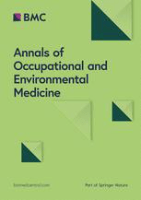
Annals of Occupational and Environmental Medicine
Connecting Research and Practice for Occupational ExcellenceAnnals of Occupational and Environmental Medicine is a premier open-access journal dedicated to the interdisciplinary study of occupational and environmental health, published by the Korean Society for Occupational & Environmental Medicine. Since its inception in 2013, this journal has become a key platform for researchers, professionals, and students alike to disseminate findings that contribute to the understanding and improvement of health in the workplace and surrounding environments. With an ISSN of 2052-4374 and ranked in the Q3 category (2023) in Public Health, this journal emphasizes innovative research and evidence-based practices in the field. Insights from the Scopus ranking, placing it at #428 out of 665 in its category, highlight its growing impact, despite being positioned in the 35th percentile. Its open-access model ensures that valuable knowledge is readily available, fostering collaboration and progression towards healthier work and living conditions globally. With an ambitious convergence of research spanning from 2014 to 2024, the journal stands as an essential resource for those committed to advancing occupational and environmental health.
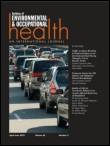
Archives of Environmental & Occupational Health
Elevating the discourse on toxicology and occupational safety.Archives of Environmental & Occupational Health is a prestigious journal published by Routledge Journals, Taylor & Francis Ltd, dedicated to advancing research and knowledge in the realms of environmental science, occupational health, and toxicology. With an ISSN of 1933-8244 and an E-ISSN of 2154-4700, this peer-reviewed journal has gained significant recognition, currently holding a Q2 ranking in Environmental Science and Q3 rankings in Health, Toxicology and Mutagenesis, and Public Health. Established in 2005, it serves as a vital platform for researchers, practitioners, and policymakers alike who aim to address and disseminate findings on pressing environmental and occupational health issues. The journal is not open access, allowing for rigorous peer review processes while still reaching a broad readership. As it converges through 2024, the Archives of Environmental & Occupational Health continues to play a critical role in shaping discourse and fostering innovation in the field, making it an essential resource for those committed to improving both human health and the environment.
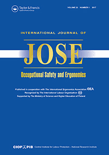
International Journal of Occupational Safety and Ergonomics
Empowering professionals with cutting-edge safety research.International Journal of Occupational Safety and Ergonomics, ISSN 1080-3548, is a leading multidisciplinary journal published by TAYLOR & FRANCIS LTD with a dedicated focus on advancing research and practices in occupational safety and ergonomics. Since its inception in 1995, this journal has provided a platform for the dissemination of innovative studies that address critical issues in public health, environmental and occupational health, and safety research. Recognized for its rigorous peer-review process, the journal holds a respectable position in the Q2 quartile rankings across multiple categories as of 2023, reflecting its impact and relevance within the academic community. It ranks 24th out of 109 in Safety Research, 198th out of 665 in Public Health, and 66th out of 207 in Safety, Risk, Reliability and Quality, showcasing its influence in these essential fields. The journal's broad scope aims to bridge gaps between research and application, ensuring that findings contribute to effective safety practices in various industries. While not an Open Access journal, the International Journal of Occupational Safety and Ergonomics remains an invaluable resource for researchers, professionals, and students seeking to stay informed about the evolving landscape of occupational safety. Its headquarters are located in Abingdon, England, serving as a conduit for scholarly communication in this vital area of study.
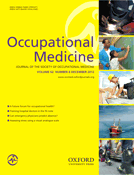
OCCUPATIONAL MEDICINE-OXFORD
Advancing Occupational Health for a Safer TomorrowOccupational Medicine-Oxford is a leading journal in the fields of public health and occupational health, published by Oxford University Press. With an ISSN of 0962-7480 and an E-ISSN of 1471-8405, this esteemed journal has been disseminating critical research findings since its inception in 1948. Ranked in the Q2 category for both Medicine (miscellaneous) and Public Health, Environmental, and Occupational Health, it occupies a significant spot in the academic community, with a Scopus ranking of #147 out of 665 in its categories, placing it within the 77th percentile. The journal aims to enhance the understanding of occupational health issues and promote practices that improve worker safety and well-being. As a vital resource for researchers, professionals, and students alike, Occupational Medicine-Oxford provides insights into emerging trends, comprehensive reviews, and original research articles that pave the way for future innovations in occupational health strategies. Explore the journal for the latest developments in this critical field, and gain access to a wealth of knowledge that can make a meaningful impact on public health policies and occupational practices worldwide.
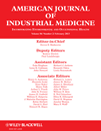
AMERICAN JOURNAL OF INDUSTRIAL MEDICINE
Championing Safety and Health in Every WorkplaceAMERICAN JOURNAL OF INDUSTRIAL MEDICINE, published by Wiley, stands out as a premier journal dedicated to the field of industrial medicine, emphasizing comprehensive research related to occupational health and safety. With an impressive impact factor, the journal holds a distinguished position in its category, ranked in the Q1 quartile for Public Health, Environmental and Occupational Health as of 2023. It has garnered respect within the academic community, ranking #141 out of 665 in Scopus, placing it in the 78th percentile. Research published here spans various topics from epidemiological studies to interventions aimed at improving worker health outcomes, appealing to a diverse audience of researchers, professionals, and students alike. The AMERICAN JOURNAL OF INDUSTRIAL MEDICINE is committed to advancing knowledge and practice in industrial health, fostering an environment where important discussions and discoveries can shape the future of occupational health globally.
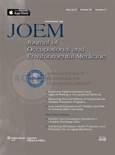
JOURNAL OF OCCUPATIONAL AND ENVIRONMENTAL MEDICINE
Elevating standards in occupational health.JOURNAL OF OCCUPATIONAL AND ENVIRONMENTAL MEDICINE, published by Lippincott Williams & Wilkins, is a premier journal dedicated to advancing the field of occupational and environmental health. With a rich history dating back to 1959 and a notable impact factor reflecting its relevance, the journal operates at the intersection of public health and environmental science, ranking in the Q2 category in the 2023 Scopus rankings within its field. It caters to a diverse audience of researchers, healthcare professionals, and students, providing a vital platform for peer-reviewed articles that address critical issues in occupational and environmental medicine. The journal’s mission is to disseminate innovative research findings and establish best practices that improve workplace safety and public health. With a focus on high-quality, evidence-based content, JOURNAL OF OCCUPATIONAL AND ENVIRONMENTAL MEDICINE plays a crucial role in shaping policy and fostering interdisciplinary collaboration among practitioners and scholars in the health sector.

Indian Journal of Occupational and Environmental Medicine
Transforming Insights into Action for Healthier WorkplacesIndian Journal of Occupational and Environmental Medicine, published by Wolters Kluwer Medknow Publications, is a pivotal resource in the field of public health, focusing on the critical intersections of occupational safety and environmental health. With the ISSN 0973-2284 and E-ISSN 1998-3670, this journal has been a beacon of knowledge since its inception in 1999 and continues to influence scholarly discourse through its convergence years culminating in 2024. Recognized for its contribution to the field with a 2023 Scopus categorization of Q3 in Public Health, Environmental and Occupational Health, it has secured its place among the top journals, ranked #453 out of 665 within its specialty, reflecting a respectable 31st percentile. While it operates on a subscription basis, the journal ensures comprehensive coverage of significant research, thereby enhancing occupational health practices and environmental health policies. It serves as a vital platform for researchers, professionals, and students dedicated to advancing knowledge and improving outcomes in these crucial areas of health. The journal's commitment to excellence is evident as it continues to cater to a diverse readership from its base in Mumbai, India.
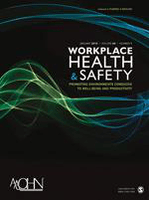
Workplace Health & Safety
Exploring critical issues in occupational health and safety.Workplace Health & Safety is a prominent peer-reviewed journal published by SAGE Publications Inc, aiming to advance the field of occupational health and safety through rigorous research and practical applications. With an impact factor reflecting its significant contributions to the fields of nursing and public health, this journal ranks in the second quartile (Q2) for both Nursing (miscellaneous) and Public Health, Environmental and Occupational Health, showcasing its standing among peers. Since its inception in 2003, the journal has been committed to disseminating insights that enhance workplace safety and health practices, making it a vital resource for researchers, professionals, and students alike. Readers can access a wealth of knowledge through its open access option, fostering a broader understanding and discussion around critical health and safety issues in various work environments. With a consistent commitment to excellence and relevance, Workplace Health & Safety is essential for anyone dedicated to improving workplace environments and promoting health and safety standards.
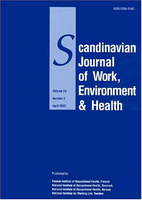
SCANDINAVIAN JOURNAL OF WORK ENVIRONMENT & HEALTH
Fostering collaboration for a healthier workforce.SCANDINAVIAN JOURNAL OF WORK ENVIRONMENT & HEALTH, published by the Scandinavian Journal Work Environment & Health, is a leading platform dedicated to advancing research in the fields of public health, environmental health, and occupational health. Established in 1975 and set to continuously evolve until 2024, this journal serves as a vital resource for scholars, practitioners, and policymakers concerned with workplace health and safety issues. Notably, it holds an impressive Q1 ranking in its category, and is positioned in the top 10% (90th percentile) of its field according to Scopus rankings, affirming its significance and impact within contemporary research. With a commitment to rigorous peer-review, the journal provides open access to cutting-edge studies, promoting knowledge dissemination and collaborative dialogue among professionals. As the landscape of work environments increasingly intersects with health outcomes, the SCANDINAVIAN JOURNAL OF WORK ENVIRONMENT & HEALTH remains an essential reference point for all those aiming to enhance workplace health criteria and public well-being.
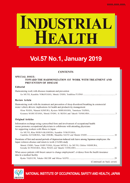
INDUSTRIAL HEALTH
Elevating Standards in Environmental and Occupational HealthINDUSTRIAL HEALTH is a premier journal dedicated to the dissemination of innovative research in the fields of public health, environmental and occupational health, as well as toxicology and mutagenesis. Published by the National Institute of Occupational Safety and Health in Japan, the journal has been a critical resource for over six decades, covering essential topics from 1963 to the present day. With an impressive placement in the second quartile (Q2) of the Public Health, Environmental and Occupational Health category and a third quartile (Q3) in Health, Toxicology, and Mutagenesis, it is recognized for its significant contribution to advancing knowledge and improving practices within the industry. While not an open-access journal, INDUSTRIAL HEALTH offers researchers and students access to a wealth of knowledge through its rich archive of articles, fostering a deeper understanding of health and safety challenges in industrial settings. The journal’s dedication to high-quality research and its strategic role in promoting occupational safety make it an invaluable asset for professionals seeking to enhance health standards and safety protocols worldwide.